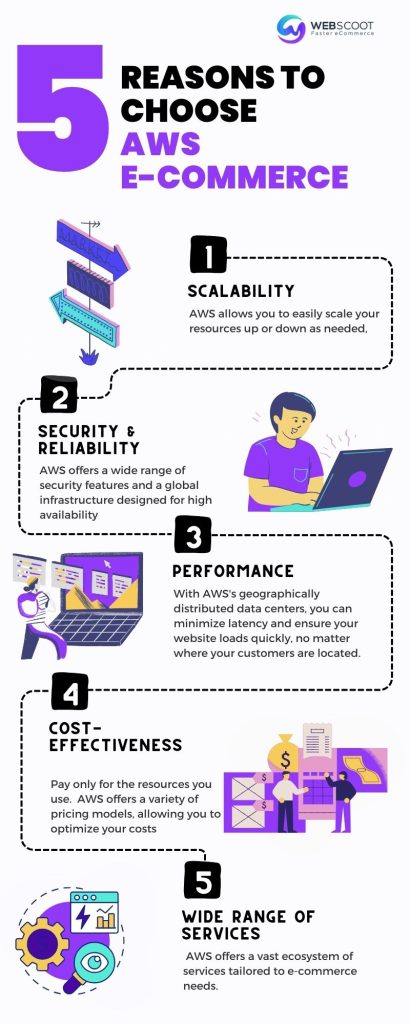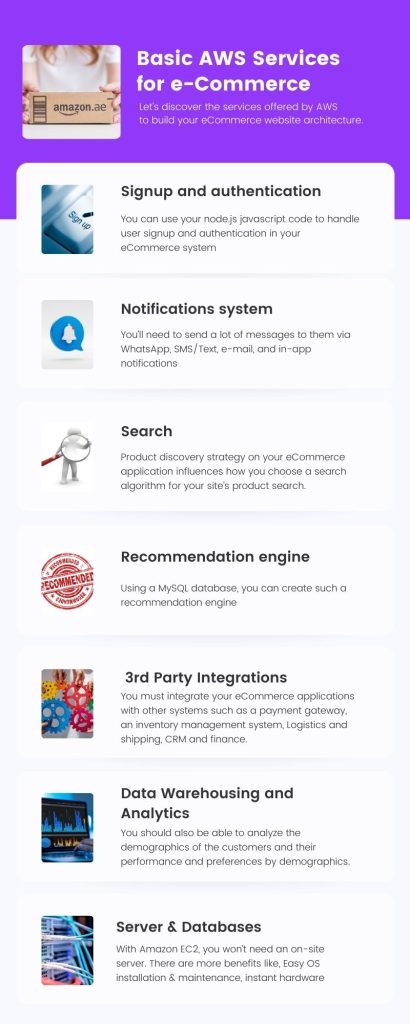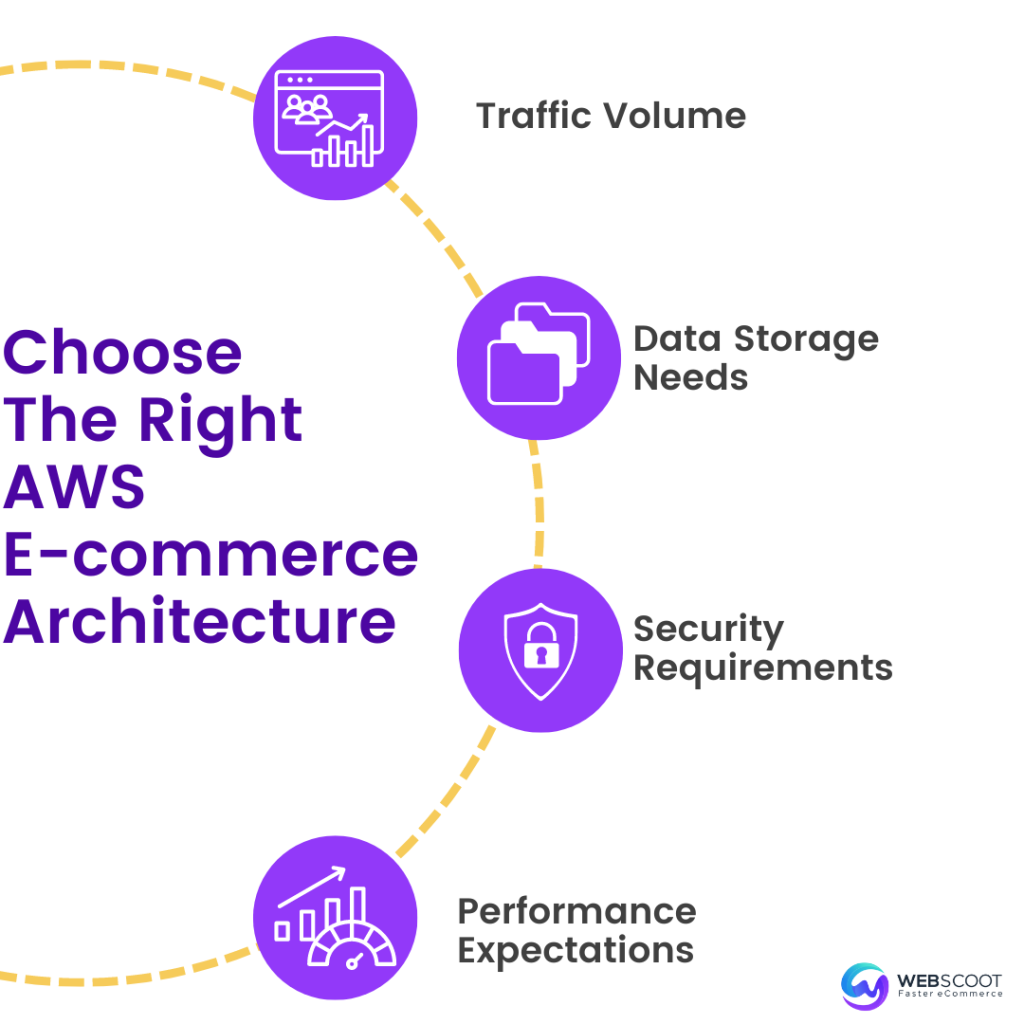It might be difficult to maintain an eCommerce website with a huge product inventory and a global consumer base. This is where AWS architecture diagram helps you.
Customers want pages to load swiftly and to find the things they’re looking for immediately. Your visitors across the world expect to be able to make purchases at any time, thus the website should always be accessible.
However, as your inventory and customer base expand, meeting these expectations get more difficult.
What’s the solution? Well, using AWS tools, you can create a well-architectured e-commerce website that is appealing, easily scalable and has a searchable product catalog.
By simply putting your applications on the cloud, you eliminate network, server, and storage maintenance difficulties.
Amazon Web Services (AWS), Microsoft Azure, and Google Cloud Platform (GCP) are the front-runners in delivering these services.
Let’s dive in!
Table of Contents
- Understanding AWS Architecture
- Why choose AWS architecture for e-commerce?
- Types of eCommerce Architecture
- AWS Architecture for eCommerce
- Foundational AWS Services Used by eCommerce
- E-commerce AWS Architecture Diagram
- Choosing the Right AWS Architecture for E-commerce
- Final Words
Before we move on to figure out what is AWS architecture for eCommerce, let’s understand what type of eCommerce architecture AWS is based on in the first place.
See Why AWS Is The One For Your eCommerce.
Understanding AWS Architecture?
An AWS architecture for e-commerce isn’t a single, pre-defined solution. Instead, it’s a customized blueprint for building your online store on the Amazon Web Services (AWS) cloud platform. This blueprint leverages various AWS services to create a secure, scalable, and efficient foundation for your e-commerce business.
Cloud architects can create safe, effective, robust, and scalable infrastructure for a range of workloads and applications with the aid of AWS Well-Architected. AWS Well-Architected is based on six pillars: operational excellence, security, dependability, performance efficiency, cost optimization, and sustainability. It offers a standardized method for partners and customers to assess architectures and put scalable solutions into practice. Domain-specific lenses, interactive labs, and the AWS Well-Architected Tool are all part of the AWS Well-Architected Framework. The free AWS Well-Architected Tool in the AWS Management Console offers a way to keep track of enhancements, identify high-risk problems, and assess workloads on a regular basis.
Why choose an AWS Architecture diagram for e-commerce?
In today’s competitive e-commerce landscape, a robust and scalable infrastructure is crucial for success. Here’s why AWS architecture shines for e-commerce businesses:

- Scalability: Accommodate sudden traffic surges during sales or peak seasons. AWS allows you to easily scale your resources up or down as needed, ensuring your website remains responsive and avoids frustrating downtime for customers.
- Security & Reliability: Protect your valuable customer data and ensure website availability. AWS offers a wide range of security features and a global infrastructure designed for high availability, giving you peace of mind.
- Performance: Deliver a fast and smooth user experience for your customers. With AWS’s geographically distributed data centers, you can minimize latency and ensure your website loads quickly, no matter where your customers are located.
- Cost-Effectiveness: Pay only for the resources you use. AWS offers a variety of pricing models, allowing you to optimize your costs based on your specific needs. This is especially beneficial for e-commerce businesses with fluctuating traffic patterns.
- Wide Range of Services: AWS offers a vast ecosystem of services tailored to e-commerce needs. From product catalogs and payment processing to content delivery networks (CDNs) and analytics tools, you’ll find everything you need to build a comprehensive e-commerce solution.
Types of eCommerce Architecture
#1. Two-tier
A two-tier design is the simplest architectural model. In this, UI runs on the client’s side while data is stored on the server side.
The logic of the business application can operate on either the side – the client or the server.
This way, the client and server run independently of one another.
Client processes give customers an interface that collects and displays data on their computers. The presentation layer refers to this section of the application. Server processes connect to the company’s data store.
The data layer refers to this element of the application.
The business logic that validates data, maintains security and permissions and executes other business processes might be stored on the client or the server.
#2. Three-tier AWS E-commerce Architecture
Despite the two-tier architecture’s simplicity may be appealing to some organizations, others may require more features.
Thus, the three-tier eCommerce architecture has the same components as the two-tier but adds a third tier: the business side.
Each of the three layers — presentation, business, and data — works as a separate module on a different server; although they work together to construct the overall architecture.
The three-tier design is superior at collecting data and improving decision-making processes to the two-tier architecture.
Let’s take a glance at each of them in more detail.
Presentation layer
The presentation layer is where the three-tier architecture begins.
Because this is frequently the section that the consumer sees, it is typically referred to as a graphic user interface or GUI.
The presentation layer consists of two parts: the front end and the back end. MVC Razor, Vue.js, React, and Angular are among the frameworks and libraries used.
In practice, this layer encompasses the start and end of processing requests or data. When it comes to processing requests, this layer employs validation to ensure that all relevant data is retrieved.
Business layer
The application’s business layer, also known as the application or service layer, lies at its heart.
It gathers and processes data using business logic; which is a collection of business rules, and it can also add, delete, or alter data in the data layer.
The business layer, for example, would be in charge of recording consumer preferences as they browse the website, look at products, and make transactions.
That said, the next time the customer login onto the website, the business layer will have already preserved the user’s selected shipping and payment methods, saving from re-entering them.
Data layer
The data tier, often known as the database layer; is the final layer in which data is stored and requests are processed.
A relational database management system, such as LINQ or SQL, can be used to store this data.
The data management component ensures that data is consistent across the distributed environment; while the middle layer houses the centralized process logic, which makes administration easier by localizing system functionality.
#3. SaaS
Software as a Service (SaaS) is a type of architecture that hosts software and data in the cloud and makes it available through a variety of web browsers.
Because the provider is in charge of maintenance, hosting, and site performance, SaaS allows you to have your site up and running in no time, with a full product catalog and backend capabilities.
Furthermore, because updates are made in real-time, a SaaS design allows retailers to swiftly upgrade their websites to the most recent version.
Moreover, merchants are spared the trouble of having to change their existing settings every time the platform is updated.
So.
What does AWS identify as?
Amazon Web Services classifies as an extensive cloud computing platform, which comprises infrastructure as a service (IaaS), platform as a service (PaaS), and packaged software as a service (SaaS) solutions.
Basic AWS Services for eCommerce
Now that we know what eCommerce system architecture, let’s discover the services offered by AWS to build your eCommerce website architecture.

1. Signup and authentication
You can use your node.js javascript code to handle user signup and authentication in your eCommerce system by storing user credentials and information in a MySQL database and managing user signup and authentication using your node.js javascript code.
2. Notifications system
To keep your customers up to date on everything they’re doing on your app, such as;
- what you’re doing with their orders
- when they’ll be shipped, and
- when they’ll arrive
you’ll need to send a lot of messages to them via WhatsApp, SMS/Text, e-mail, and in-app notifications.
3. Search
The importance of search as a product discovery strategy on your eCommerce application influences how you choose a search algorithm for your site’s product search.
If you have a small number of products and aren’t adding new ones every day or regularly, a sophisticated search engine may be a waste of time and resources.
However, if you have a large number of products and want customers to be able to accurately search for them, you should invest in a sophisticated search engine that can better understand their intent.
4. Recommendation engine
Customers should be shown recommendations based on what they are looking at on your website, such as Amazon’s “customers who bought this also bought this section”, or based on “buy again” and here is your browsing history.
Using a MySQL database, you can create such a recommendation engine by performing queries on previous orders and displaying the results on the customer’s results page.
If your consumers are few and don’t mind the search query taking a long time to load, this will work well.
5. 3rd Party Integrations
You must integrate your eCommerce applications with other systems such as a payment gateway to accept payments from customers, an inventory management system to display available products to customers, logistics and shipping to ship orders to customers and manage returns; CRM to manage customer history, and finance to manage all financial information about a transaction conducted on your website.
6. Data Warehousing and Analytics
You’ll need a system that allows you to examine all of the data coming in from multiple sources.
You should be able to see all of the visitors coming in, how much time they spend on the site, what they buy or abandon, which products are performing well, which marketing campaigns are working and which are not, which ads are performing, or not, and so on.
You should also be able to analyze the demographics of the customers and their performance and preferences by demographics.
Add in an examination of shipping and handling as well as inventory to determine what’s in stock, what’s not, how long it takes to complete an order, etc.
Now that we know the components of the architecture for your eCommerce, let’s break down the services offered by AWS to fulfil these requirements.
1. Server & Databases
1.1. Amazon EC2 Service
With Amazon EC2, you won’t need an on-site server. There are more benefits to it as well – such as;
- Easy OS installation & maintenance
- Instant hardware setup
- Higher scalability
- Cost-Effective
The major advantage of adopting EC2 instances for eCommerce sites is that they are charged based on usage, extra resources are automatically allocated to them during peak usage, and the prices are greater only during those periods.
E-commerce AWS Architecture Diagram
Here’s an example to learn how to build an AWS Architecture for eCommerce.
Let’s suppose we want to create an eCommerce app that can be used on an Android phone, an iPhone, a mobile website, a desktop website, or a tablet website.
To receive and fulfil orders, as well as manage refunds, the site would need to interact with numerous internal and external partners.
Here is an AWS eCommerce Architecture diagram for your reference;
Web Frontend
This is a AWS reference architecture for an eCommerce website’s web front end. Route 53, CloudFront, Elastic Beanstalk, S3, ElastiCache, DynamoDB, and CloudSearch are among the services used:
Checkout Pipeline
This is a reference architecture for an eCommerce site’s secure and high-availability checkout pipeline service. The Virtual Private Cloud, Simple Workflow Service, Elastic Beanstalk, Relational Database Service, and Simple Email Service are all used.
Marketing & Recommendations Service
This is a reference AWS architecture diagram tool for an eCommerce site’s marketing and recommendation service. Elastic MapReduce, S3, Elastic Beanstalk, the Relational Database Service, DynamoDB, and the Simple Email Service are all used in this.
Choosing the Right AWS Architecture for E-commerce
There’s no one-size-fits-all solution when it comes to AWS architecture. The ideal setup depends on your specific needs and business size. Here’s a breakdown of some key considerations:

- Traffic Volume: Do you have a small, established store, or are you expecting high volumes from day one? Scalability becomes more critical with higher traffic.
- Data Storage Needs: The type and amount of product data you store will influence your storage choices on AWS.
- Security Requirements: The level of security needed depends on the type of data you handle (e.g., credit card information). AWS offers various security features to meet your specific needs.
- Performance Expectations: How crucial are lightning-fast loading times for your target audience? CDNs and optimized server configurations play a vital role in website performance.
Here’s a simplified approach to choosing your AWS architecture:
- Small-Scale Stores: For startups or businesses with modest traffic, consider a basic architecture using S3 for storage, EC2 instances for compute power, and CloudFront for content delivery.
- Medium-Scale Stores: As your business grows, explore managed services like Amazon DynamoDB for product catalogs and Amazon RDS for databases.
- Large-Scale Stores: For high-traffic e-commerce giants, leverage a combination of services like Elastic Beanstalk for application deployment, Amazon Aurora for scalable databases, and Auto Scaling for automatic resource provisioning.
Remember, this is just a starting point. AWS offers a wealth of resources – documentation, whitepapers, and solution architects – to help you design the perfect architecture for your unique e-commerce needs.
Final Words
As you can see, you can leverage the cloud platform components provided by AWS architecture reference to run your eCommerce application for all of your simple and sophisticated technological requirements. It is always better to get help with infrastructure operations and management while you focus on development and strategy.
You can even host your complete application serverless by repurposing your code to run on AWS Lambda.
AWS eCommerce architecture is, in easy words, all in one to get your eCommerce business up and running, or even if you want to migrate to AWS architecture – Talk to our experts!
You need to create a solid foundation for your website’s structure and function before investing in the design, marketing, and other features of your eCommerce business.
The AWS Architecture diagram for eCommerce gives you just that.
Have any questions? Let us know in the comments!
Next read – AWS Vs Digital Ocean: 5 Point Comparison.

Sakshi takes care of everything related to Marketing at Webscoot.io. She has knowledge about Magento, WordPress, and Dogs.

0 Comments